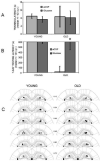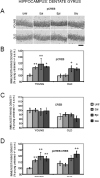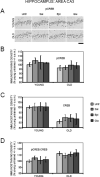Epinephrine and glucose modulate training-related CREB phosphorylation in old rats: relationships to age-related memory impairments
- PMID: 23201424
- PMCID: PMC3557608
- DOI: 10.1016/j.exger.2012.11.010
Epinephrine and glucose modulate training-related CREB phosphorylation in old rats: relationships to age-related memory impairments
Abstract
Epinephrine enhances memory in young adult rats, in part, by increasing blood glucose levels needed to modulate memory. In old rats, epinephrine is deficient at raising blood glucose levels and thus is only moderately effective at enhancing memory. In contrast, systemic glucose injections improve memory in old rats, with resulting memory performance equal to that of young rats. The diminished response of glucose to training in old rats may blunt downstream neurochemical and molecular mechanisms needed to upregulate memory processes. In the first experiment, young adult and old rats were trained on an inhibitory avoidance task with immediate post-training injections of aCSF or glucose into the dorsal hippocampus. Old rats had significant memory impairments compared to young rats 7 days after training. Intrahippocampal injections of glucose reversed age-related deficits, improving memory scores in old rats to values seen in young rats. A second experiment examined age-related changes in activation of the transcription factor CREB, which is widely implicated in memory formation and may act downstream of hormonal and metabolic signals. Activation was assessed in response to training with systemic injections of epinephrine and glucose at doses known to enhance memory. Young adult and old rats were trained on inhibitory avoidance with immediate post-training systemic injections of saline, epinephrine, or glucose. After training, old rats had significant impairments in CREB phosphorylation in area CA1 and the dentate gyrus region of the hippocampus, and in the basolateral and lateral amygdala. Epinephrine and glucose attenuated age-related deficits in CREB phosphorylation, but were more effective in the amygdala and hippocampus, respectively. Together, these results support the view that age-related changes in blood glucose responses to epinephrine contribute to memory impairments, which may be related to alterations in regional patterns of CREB phosphorylation.
Copyright © 2012 Elsevier Inc. All rights reserved.
Figures





Similar articles
-
Age-related impairments in memory and in CREB and pCREB expression in hippocampus and amygdala following inhibitory avoidance training.Mech Ageing Dev. 2012 May;133(5):291-9. doi: 10.1016/j.mad.2012.03.004. Epub 2012 Mar 16. Mech Ageing Dev. 2012. PMID: 22445851 Free PMC article.
-
Age-related memory impairments due to reduced blood glucose responses to epinephrine.Neurobiol Aging. 2010 Dec;31(12):2136-45. doi: 10.1016/j.neurobiolaging.2008.12.003. Epub 2009 Jan 28. Neurobiol Aging. 2010. PMID: 19178987 Free PMC article.
-
Alteration of CREB phosphorylation and spatial memory deficits in aged 129T2/Sv mice.Neurobiol Aging. 2008 Oct;29(10):1533-46. doi: 10.1016/j.neurobiolaging.2007.03.023. Epub 2007 May 2. Neurobiol Aging. 2008. PMID: 17478013
-
Glucose and age-related changes in memory.Neurobiol Aging. 2005 Dec;26 Suppl 1:60-4. doi: 10.1016/j.neurobiolaging.2005.09.002. Epub 2005 Oct 11. Neurobiol Aging. 2005. PMID: 16225962 Review.
-
Forgetfulness during aging: an integrated biology.Neurobiol Learn Mem. 2014 Jul;112:130-8. doi: 10.1016/j.nlm.2014.03.005. Epub 2014 Mar 24. Neurobiol Learn Mem. 2014. PMID: 24674745 Free PMC article. Review.
Cited by
-
Making memories matter.Front Integr Neurosci. 2012 Dec 18;6:116. doi: 10.3389/fnint.2012.00116. eCollection 2012. Front Integr Neurosci. 2012. PMID: 23264764 Free PMC article.
-
Involvement of lactate transport in two object recognition tasks that require either the hippocampus or striatum.Behav Neurosci. 2019 Apr;133(2):176-187. doi: 10.1037/bne0000304. Behav Neurosci. 2019. PMID: 30907617 Free PMC article.
-
Inactivation of the striatum in aged rats rescues their ability to learn a hippocampus-sensitive spatial navigation task.Neurobiol Learn Mem. 2020 Jul;172:107231. doi: 10.1016/j.nlm.2020.107231. Epub 2020 Apr 17. Neurobiol Learn Mem. 2020. PMID: 32305514 Free PMC article.
-
Breakfast Consumption Habits at Age 6 and Cognitive Ability at Age 12: A Longitudinal Cohort Study.Nutrients. 2021 Jun 17;13(6):2080. doi: 10.3390/nu13062080. Nutrients. 2021. PMID: 34204553 Free PMC article.
-
Aging is not equal across memory systems.Neurobiol Learn Mem. 2020 Jul;172:107232. doi: 10.1016/j.nlm.2020.107232. Epub 2020 Apr 18. Neurobiol Learn Mem. 2020. PMID: 32315762 Free PMC article.
References
-
- Aguiar AS, Jr., Castro AA, Moreira EL, Glaser V, Santos AR, Tasca CI, Latini A, Prediger RD. Short bouts of mild-intensity physical exercise improve spatial learning and memory in aging rats: involvement of hippocampal plasticity via AKT, CREB and BDNF signaling. Mech. Ageing Dev. 2011;132:560–567. - PubMed
-
- Assunção M, Santos-Marques MJ, Carvalho F, Andrade JP. Green tea averts age-dependent decline of hippocampal signaling systems related to antioxidant defenses and survival. Free Radic. Biol. Med. 2010;48:831–838. - PubMed
-
- Barnes CA. Memory changes with age: neurobiological correlates. In: Martinez JL, Kesner RP, editors. Learning and Memory: A Biological View. Academic Press; New York: 1991. pp. 259–296.
-
- Barros DM, Izquierdo LA, Sant'Anna MK, Quevedo J, Medina JH, McGaugh JL, Izquierdo I. Stimulators of the cAMP cascade reverse amnesia induced by intra-amygdala but not intrahippocampal KN-62 administration. Neurobiol. Learn. Mem. 1999;71:94–103. - PubMed
Publication types
MeSH terms
Substances
Grants and funding
LinkOut - more resources
Full Text Sources
Other Literature Sources
Medical
Miscellaneous

